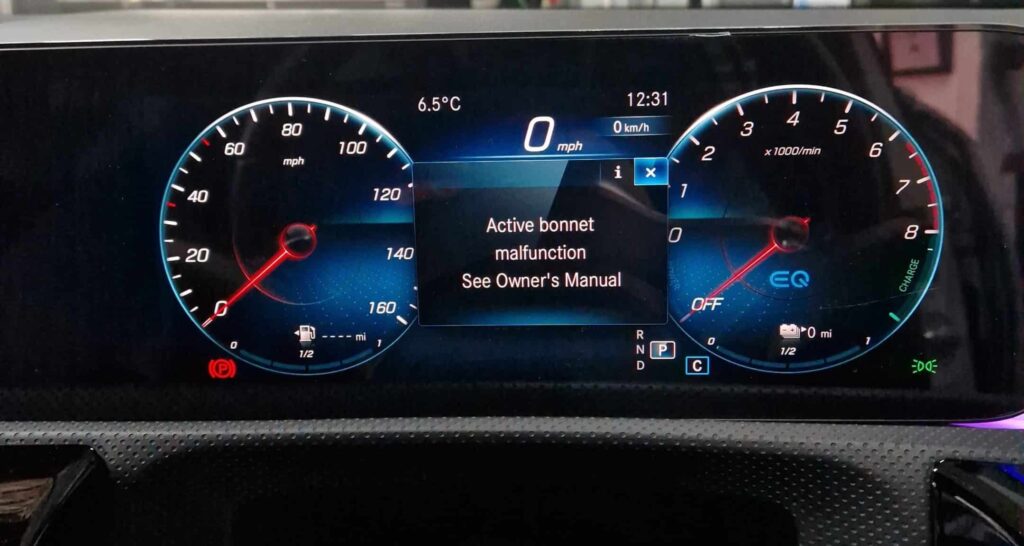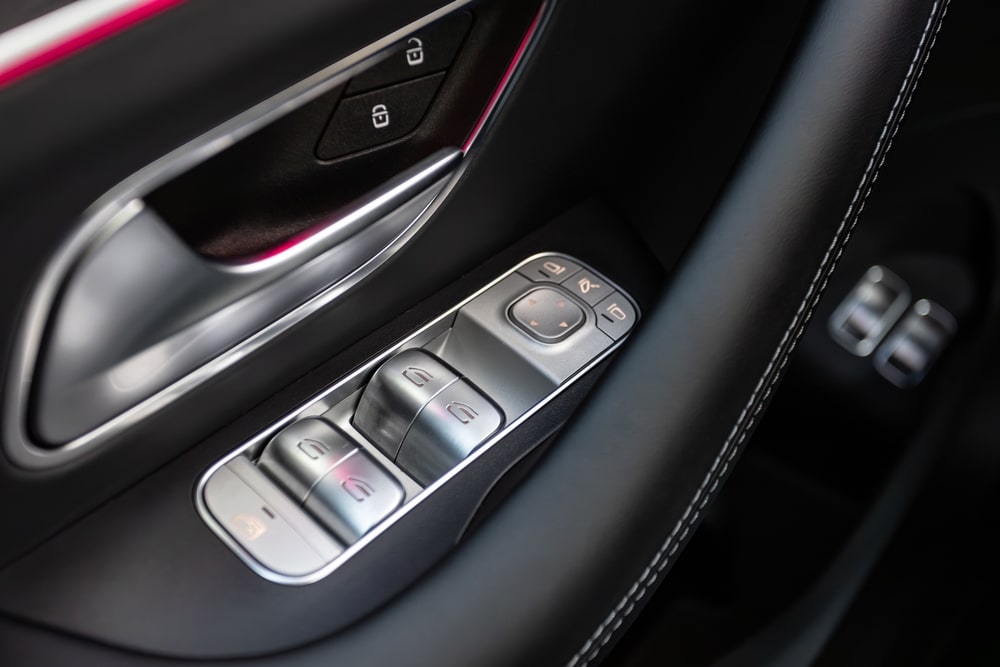Active Bonnet Malfunction
Mercedes engineering hides some of its most impressive ideas where you least expect them — right under the bonnet.
Built into the hinges is a system that reacts in an instant, lifting the bonnet in a fraction of a second to soften the impact if the worst should happen and a pedestrian steps into your path. It’s the sort of safety design you never want to rely on… but you’d want it working flawlessly if you did. This is the Active Bonnet system.
When that system failed on a Mercedes A-Class in Northampton, it wasn’t a repair to be left to chance. At Roade Main Garage, our technicians drew on Mercedes experience, a clear diagnostic routine, and specialist testing tools to uncover the exact cause and deliver the right fix first time. No guesswork, no wasted part swaps — just an accurate repair that restored the vehicle’s safety credentials.
Here’s how we confirmed the problem, proved it beyond doubt, and returned this Mercedes ready to protect when it matters most… without the dealer price tag.

Mercedes Active Bonnet: What It Does
The Active Bonnet system is a safety innovation designed by Mercedes to reduce pedestrian injuries in a collision. Small pyrotechnic charges, known as squibs, are built into the rear bonnet hinges. When triggered, they lift the back edge of the bonnet by about 80mm in a split second. This rapid movement creates an energy-absorbing gap between the bonnet and the solid engine parts beneath, helping to reduce the severity of impact if a pedestrian is struck.
Control of the system comes from the vehicle’s Supplemental Restraint System (SRS) unit, which uses crash sensors in the front bumper to detect a qualifying impact. Each hinge is fitted with its own bonnet lifter, and once activated, the bonnet stays slightly raised until reset. While the bonnet can be pushed back down so the car can still be driven, the safety function is lost until the issue is repaired.
Where the Diagnosis Began for Fault Code B2730
When the Mercedes A-Class came into Roade Main Garage, the driver was worried by the dashboard warning: “Active Bonnet Malfunction – see owner’s manual.” This isn’t a message you can afford to brush aside. If the system isn’t active, that crucial layer of pedestrian protection won’t be there when it matters most.
Our technicians connected a Mercedes dealer-level diagnostic tool to the vehicle and carried out a complete scan. This is the same equipment used in main dealerships, giving us direct access to manufacturer data and guided testing routines. The scan identified a stored code: B2730 – Left Rear Engine Hood Lifter Squib Malfunction. In simple terms, the SRS control unit had registered a fault in the squib for the left-hand bonnet lifter.
While this pointed us to the area of concern, our experience with Mercedes systems has taught us that a fault code is only the starting point. A code indicates where the system has noticed a problem, not why it happened. To uncover the true cause, we worked through our structured diagnostic process: reviewing serial data, inspecting wiring and connectors, and checking associated control modules to rule out any underlying issues that could trigger future warnings.
Confirming the Cause of the Active Bonnet Malfunction
Once the initial scan was complete, we moved on to a detailed investigation. At Roade Main Garage in Northampton, that meant following our structured multi-step diagnostic routine, backed by Mercedes expertise and the same dealer-level equipment and technical data used by the manufacturer.
Our first step was to review Mercedes-Benz’s official guidance for Fault Code B2730. This confirmed that the code refers to a fault in the squib circuit for the left bonnet lifter. With that knowledge, our task became clear: identify why the circuit was showing a problem, rather than assume the lifter itself was to blame.

We then compared serial data from both the left and right lifter circuits. The right-hand side showed normal activity, while the left displayed no signal at all — a typical indicator of an open circuit. Running this side-by-side check was essential, as it gave us a control to prove the fault was isolated and genuine.
Next, our technicians examined the wiring and connectors supplying the left-hand lifter. We inspected for any corrosion, loose pins, or damage, then ran continuity and resistance checks to make sure the wiring could carry a signal. All readings were within the correct range, confirming the wiring was intact.
With wiring integrity ruled out and the serial data consistently showing an open circuit at the left lifter squib, we could confidently conclude that the lifter had failed internally. By following this methodical process, we ensured the correct part was identified first time, avoiding trial and error, preventing unnecessary expense, and preparing this vital safety system to be fully restored.
The Repair That Restored the Active Bonnet System
With the fault confirmed, we spoke with the customer to outline exactly what we had uncovered and the steps needed to put it right. Clear communication is vital, particularly with safety-critical systems such as the Active Bonnet. Once we had their go-ahead, our technicians followed Mercedes’ strict safety protocols for handling pyrotechnic components, disconnecting the battery and waiting for the system to discharge before removing the defective left bonnet lifter.
A replacement lifter was then fitted to Mercedes’ torque settings, guaranteeing correct positioning and secure installation. After this, we compared readings from the left and right bonnet lifter circuits. This stage is essential; without it, the control unit may continue to log a fault and keep the system inactive.
To finish, we carried out a complete post-repair validation. This involved erasing the stored fault code, verifying through serial data that the Active Bonnet system was fully functional, and ensuring no associated errors remained. With every test passed, the A-Class was returned to its owner with its pedestrian safety system back at full strength.
Active Bonnet Warning Cleared and System Verified
With the repair complete, this Mercedes A-Class left Roade Main Garage in Northampton with its Active Bonnet Malfunction warning cleared and the system functioning exactly as intended. The Active Bonnet system, a key element of the car’s pedestrian protection, was once again ready to respond if ever required.
By pinpointing the exact issue and replacing only the faulty lifter, our technicians ensured the repair was both precise and cost-effective. Using Mercedes technical data, dealer-level tooling, and a methodical testing routine, we achieved a first-time fix that met the manufacturer’s safety standards.
For the customer, it meant more than just removing an alert from the dashboard. It delivered reassurance that their Mercedes’ pedestrian safety system would respond within milliseconds if needed, and peace of mind knowing the job had been carried out to the highest standard.
Book Your Mercedes Active Bonnet Repair in Northampton
If your Mercedes displays an Active Bonnet Malfunction warning, it’s not something to delay. This system is a vital part of your vehicle’s pedestrian safety package, and if it isn’t active, the protection it’s designed to deliver simply won’t work in an emergency. If you spot a warning, call the Mercedes specialists at Roade Main Garage on 01604 862262.
Our Mercedes-trained team in Northampton follow a proven diagnostic process, supported by dealer-level equipment, to pinpoint faults accurately the first time and give you complete confidence in your repair.
Other reasons to choose Roade Main Garage include:
- 12-month parts and labour guarantee
- Dealer-level expertise without dealer prices
- Access to specialist Mercedes safety data and tools
Drivers rate us {{average-rating}} stars on Google, with feedback from {{review-count}} happy customers.
Don’t risk driving with compromised safety systems. Call Roade Main Garage on 01604 862262 today to arrange a professional evaluation and restore your Mercedes to full safety standards.



